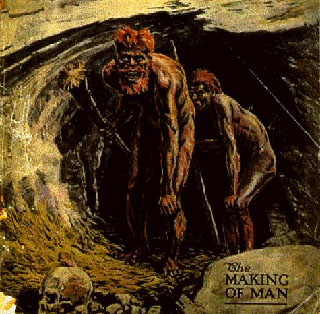|
GrottmänniskorPå stenåldern bodde alla i grottor Many people think that our ancestors in the Stone Age lived in caves. After all, some people use the term cavemen to refer to primitive people. But very few Stone Age people were cave dwellers. Caves didn't make pleasant houses. They were damp and dark. Few caves were big enough for a whole family. Even fewer were located near good supplies of freshwater and game for hunting. Woods & Woods Prehistoric men are commonly referred to in the popular press, in literature and in films as 'cave men'. The great majority of early humans, however, could not have lived in caves, because there were just not enough caves to accommodate them. Natural caves and rock-shelters are largely restricted to limestone country and vast areas of the land surface, on which early humans must have lived, simply have no caves. If these people had shelters at all, they must have been simple structures of branches, leaves and skins which stood no chance of preservation. Derek Ager Stenålderskulturer - jägare och samlare - lämnar inte många spår efter sig till att börja med, åtminstone vad beträffar sådana som går att hitta ens några sekel senare. Även om man tänker sig att arkeologerna skulle få en plats utpekad för sig, där ett sådant samhälle för säg 10 000 år sedan haft sina hyddor under ett antal generationer - tänk ett indianläger, där de dominerande materialen var trä, skinn, ben och horn, och så några värdefulla yxor och pilspetsar i sten - så har sedan dess biologiska processer, senare generationers lantbruk, istider och en del annat dessutom, sett till att praktiskt taget ingenting finns kvar (även om man med teknik och skicklighet kan utläsa otroligt mycket även av just praktiskt taget ingenting, som stolphål och pollenspår). I grottor får gravar, artefakter och rentav grottmålningar vara ifred på ett helt annat sätt, och det är därför vi hittar så mycket i dem. Som i Neandertal i Tyskland, Les Eyzies-de-Tayac (Cro-Magnon) i Frankrike, Altamira i Spanien, Liang Bua-grottorna på Flores, med flera exempel. Men även de grottor som användes som bostäder var undantag, inte regel. Många grottmålningar finns i synnerligen svåråtkomliga grottor som aldrig använts som bostäder. The term has been discouraged for its inaccuracy, as it mostly refers to misconceptions of early humans. In the past, many people shared the view of the 17th century philosopher Thomas Hobbes that the life of early humanity and the state of nature was "...solitary, poore, nasty, brutish and short". The modern scientific perception of prehistoric lifestyle is now that of the hunter-gatherer. Wikipedia
As the weather hardened to its maximum of severity, the Neanderthal men, already it would seem acquainted with the use of fire, began to seek shelter under rock ledges and in caves and so leave remains behind them. Hitherto they had been accustomed to squat in the open about the fire, and near their water supply. But they were sufficiently intelligent to adapt themselves to the new and harder conditions. H. G. Wells (1920)
Det finns också exempel på att stenåldersfolk uppfört bostäder av varaktiga material, som t.ex. de fantastiska stenhusen i skotska Skara Brae. Där skulle familjen Flinta ha känt sig hemma. Referenser:
|




